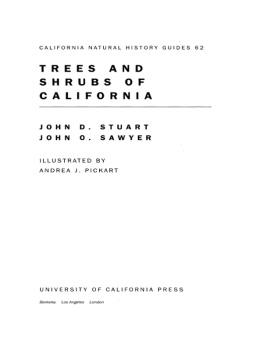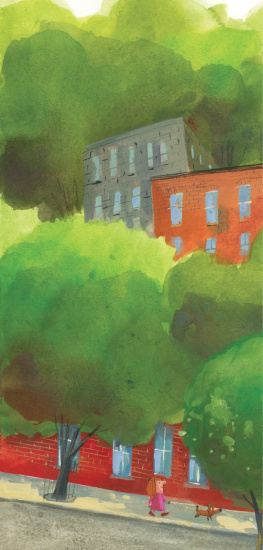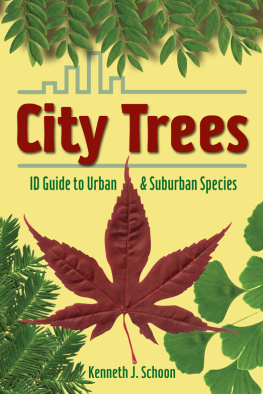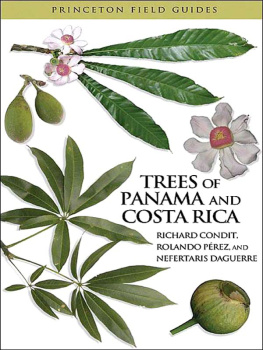FIELD GUIDE TO THE STREET TREES OF NEW YORK CITY


FIELD GUIDE TO THE STREET TREES OF NEW YORK CITY

LESLIE DAY
ILLUSTRATED BY
TRUDY SMOKE
Foreword by Amy Freitag

2011 The Johns Hopkins University Press
All rights reserved. Published 2011
Printed in China on acid-free paper
9 8 7 6 5 4 3 2 1
The Johns Hopkins University Press
2715 North Charles Street
Baltimore, Maryland 21218-4363
www.press.jhu.edu
Library of Congress Cataloging-in-Publication Data
Day, Leslie, 1945
Field guide to the street trees of New York City / Leslie Day.
p. cm.
Includes bibliographical references and index.
ISBN-13: 978-1-4214-0151-5 (hardcover : alk. paper)
ISBN-13: 978-1-4214-0152-2 (pbk. : alk. paper)
ISBN-10: 1-4214-0151-7 (hardcover : alk. paper)
ISBN-10: 1-4214-0152-5 (pbk. : alk. paper)
1. Trees in citiesNew York (State)New YorkGuidebooks. 2. Natural historyNew York (State)New YorkGuidebooks. 3. New York (N.Y.)Guidebooks. I. Title.
SB436.D39 2011
508.747dc22 2011002626
A catalog record for this book is available from the British Library.
All photographs are by Leslie Day, with the following exceptions: (bottom), courtesy Alexander Lein
All watercolor plates 2011 Trudy Smoke
Maps by Alan Robbins
Special discounts are available for bulk purchases of this book.
For more information, please contact Special Sales at 410-516-6936 or specialsales@press.jhu.edu.
The Johns Hopkins University Press uses environmentally friendly book materials, including recycled text paper that is composed of at least 30 percent post-consumer waste, whenever possible.
Book design by Kimberly Glyder

FOR OUR MOTHERS, ADELE AND LUCY, WHO HAD GREEN THUMBS
Leslie Day and Trudy Smoke


CONTENTS
, BY AMY FREITAG


FOREWORD
NEW YORK CITY, universally known as the Big Apple, naturally prefers that apple to be green. As one of the greatest cities in the world, our vast urban forest also makes it one of the greenest, most valuable environmental assets along the East Coast.
Trees can be found along our streets; in our parks and community gardens; surrounding our schoolyards and playgrounds; in front of our cultural institutions, businesses, and places of worship; and on front- and backyards across the five boroughs. New York Citys urban forest is composed of more than 5 million trees and 168 unique species. More than 600,000 of these trees line avenues and streets New Yorkers and millions of visitors pass every day.
In this beautifully illustrated book, Dr. Leslie Day introduces us to New Yorks street trees and encourages each of us to be thoughtful and caring stewards of our citys urban forest. Her book introduces us to the diverse tree species that exist in New York City, identifies and maps some of the citys most historic and great trees, and provides steps for caring for and protecting street trees. This guide invites readers to grow closer to the trees that cool our streets and sidewalks, help clean our air and water, increase our property values, and encourage neighborhood revitalization.
The New York City Department of Parks and Recreation and the New York Restoration Projectin partnership with hundreds of nonprofit partners and thousands of volunteersare planting 1 million trees across the citys five boroughs by 2017, including 220,000 new street trees. This public-private partnership will increase our urban forest by an astounding 20%, while achieving many quality-of-life benefits afforded by an expanded urban forest.
Our ambitious citywide tree-planting programs and stewardship initiatives are critical components of our citys long-term health and sustainability. New Yorkers need trees, but more important, our citys trees need us to take care of them so that they can grow strong and healthy for future generations of New Yorkers.
By greening New York City one block at a time, well be a million trees richer in 2017. As a result, well enjoy all of the health, environmental, and economic benefits trees provide. Using this book, you too can dig in and discover the street trees of New York City and help plant, protect, and preserve our citys great and growing urban forest.
Amy Freitag
Executive Director
New York Restoration Project

ACKNOWLEDGMENTS
WHEREVER WE WENT in the five boroughs to observe, photograph, and find our 50 species of trees, we met New Yorkers who cherish their leafy neighbors. We thank you allyou are an inspiration. We wish to specifically acknowledge the following people who have devoted much of their lives to caring for and about the trees of New York City: Nina Bassuk, Adrian Benepe, Sam Bishop, Wayne Cahilly, Elizabeth Ewell and the Greenkeepers, Jennifer Greenfeld, John Kilcullen, Bill Logan, Chelsea Mauldin, David Moore, Karla Osorio-Perez, Barrett Robinson, Judith Stanton, Susan Strazzera, Bruce Tilley, Nancy Wolf, and Christie Van Kehrberg. They made time to meet with us and explain their work and the work and needs of trees, and for that we are so grateful. We also wish to thank Alan Robbins for the borough maps he created to illustrate the neighborhoods of New York City. We thank the following in the Forestry Division of New York City Department of Parks and Recreation for their help: Anne Arrowsmith, Joseph Kocal, Jonathan Pywell, Brandon Schmitt, Matthew Stephens, Maria Trimble, and Laura Wooley. Susan Gooberman, Executive Director, and Cheryl Blaylock, Director of Youth Education of Trees New York, Sam Bishop Sr., President of the New York Street City Tree Consortium, and Katie Ellman, President of Green Shores NYC were helpful and supportive.
For their caring and support, we thank Jim Nishiura, Alan Robbins, Jonah Nishiura, Gina Auletta, David Wohl, Faith Wohl, Nancy Peters, Nancy Leff, Leslie Robbins, Kathy Egan, Beth Weinstein, Naomi Silverman, Jill Benzer, and The Elisabeth Morrow School community, especially Nancy Dorrien, Gil Moreno, Lisa Nicolaou, Al Mule, Jerry Mulligan, David Lowry, Germaine DiPaolo, and Aaron Cooper. We thank the art teachers at the New York Botanic Garden: Wendy Hollender, Laura Vogel, Dick Rauh, Louisa Rawle Tin, and the students, teachers, and staff of the English Department at Hunter College, especially Cristina Alfar, Harriet Luria, Barbara Webb, Thom Taylor, and Dennis Paoli. Thanks to Andre Barnett, our copyeditor, for making this book read so beautifully. Finally, we thank our funny, brilliant, and supportive editor, Vincent J. Burke, for giving us the opportunity to work together on this project.
Next page


















